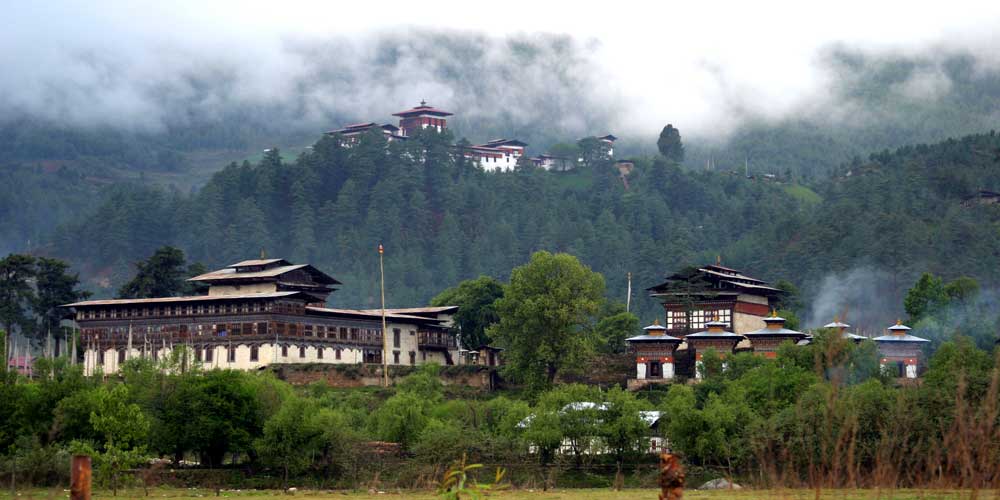
Altitude: 2600m-4000m
Bumthang is one of the loveliest valleys and the spiritual heartland of Bhutan. The entire valley is dotted with sacred temples and monasteries dating back to the 7th century. Legendary saint Guru Rinpoche (second Buddha) made first footsteps in Bumthang when he was bringing Buddhism to Tibet and Bhutan in the 8th century.
Longchen Rabjampa, (1308–1364) a great saint and scholar described Bumthang as a “Vision of Paradise” and a “Lotus in Bloom”. He also mentioned that Bumthang will be the birthplace of Jampa or Maitreya, the Buddha of the Future. Jampa Lhakhang, one of the most sacred 7th century temples in Bumthang, has the statue of Jampa (Maitreya) as the central figure. There are also three stone steps inside the temple believed to represent past, present and future. They are slowly sinking into the ground. The faithful say that when all the steps disappear the future Buddha will arrive and we will all gather in Bumthang valley to receive his teachings. Many people also refer to Bumthang as the “Switzerland of Bhutan” because of its spectacular open valleys, breathtaking scenery, beautiful rivers and mountains.
Places of Interest
Jakar Dzong, ‘The Fortress of the White Bird’ was initially built as a monastery in 1549. It was upgraded after the Zhabdrung had firmly established his power in 1646. The Dzong is now used as administrative centre for Bumthang valley and houses the regional monk body.
Jambay Lhakhang is sacred monastery built in 7th century by the Tibetan King, Songtsen Gampo. It is one of the 108 monasteries built by him to subdue evil spirits in the Himalayan region.
Kurjey Lhakhang is another sacred monastery which comprises three temples. The one on the right was built in 1652 on the rock face where Guru Padmasambhava meditated in the 8th century. The second temple is built on the site of a cave containing a rock with the imprint of the Guru Padmasambhava’s body and is therefore considered the holiest. The third temple was built by the Queen Mother Ashi Kesang Choden Wangchuk. These three temples are surrounded by a wall with 108 chortens.
Tamshing Lhakhang is located opposite Kurjey Lhakhang on the other side of the river, was founded in 1501 by Terton Pema Lingpa. The Lhakhang has ancient religious paintings such as the 1,000 Buddhas and 21 taras (female form of Bodhisattva). The temple was restored at the end of the 19th century.
Mebar Tsho or the burning lake is one of Bhutan’s sacred pilgrimage sites where sacred scriptures hidden by Guru Padmasambhava in the 8th century was recovered by Terton Pema Lingpa in the 15th century. The extensive array of prayer flag and small clay offering called ‘tsa tsa’ in rock niches bespeak the importance of this spot.
Thangbi Goenpa is towards north of Kurjey Lhakhang. It was founded in 1470 by Shamar Rinpoche of the Kagyu religious school. The temple has two sanctuaries and a temple of protective deities. The sanctuary on the ground floor contains Buddhas and three clay statues probably dating to the end of 15th century. The vestibule on the upper floor contains two remarkable paintings of the heavens of Guru Padmasambhava and Buddha Amitabha.
Ngang Lhakhang is located 100m above the valley floor. It was built in the 15th century by Lama Namkha Samdrup, a contemporary of Pema Lingpa. A three-day festival with masked dances is held here each winter to honour the founder of the Lhakhang.
Ura Valley is about one and half hour drive form Jakar and is the highest of Bumthang’s valleys. It is believed to be the earliest inhabited place in Bhutan. The road to Ura climbs to an amazingly open countryside, only occasionally running into forest. Large sheep pastures line the road up to 20 km behind the southern tip of the Tang Valley. The route crosses Ura La (3,600m) with magnificent view of Mount Gangkar Puensum. Villages in Ura have a new temple dedicated to Guru Padmasambhava. The last 25 years have seen Ura transform from a marginal community to a prosperous valley.